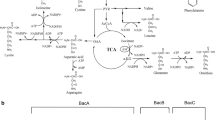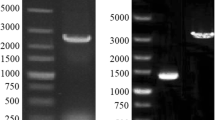Abstract
Bacitracin is a cyclic dodecyl peptide antibiotic that is an effective bacteriocide against Gram-positive and some Gram-negative bacteria. Bacitracin has been widely used as an antibacterial feed additive for livestock since it is not absorbed easily by the intestine and is easily excreted. Precursor availability has been proven to be one of the core factors for bacitracin production by many previous studies. In this study, we focused on enhancing the supply of the precursor amino acid l-ornithine to enhance bacitracin production by Bacillus licheniformis DW2 through systematic metabolic pathway modification. Several genes encoding rate-limiting enzymes for l-ornithine biosynthesis were episomally overexpressed, including argB, rocF, ppnk1, and ppnk2. The results showed that the overexpression of ppnK1 was the most effective for both l-ornithine and bacitracin biosynthesis. Secondly, the competitive branch pathways for l-ornithine biosynthesis were blocked, and the repressor was also deleted to boost l-ornithine biosynthesis. The results suggested that the deletion of genes proB and proJ to prevent proline biosynthesis and the disruption of the gene encoding the arginine repressor ArgR could enhance the intracellular concentration of l-ornithine by 49% and 2.1 times respectively, and the bacitracin production also increased accordingly by 6.6% and 11.9% respectively. Finally, several most effective efforts were combined to construct the optimal strain DW2ΔproBΔproJΔargR::ppnk1. In the optimal strain, the NADPH availability was improved and the expression levels of several essential genes for l-ornithine biosynthesis were upregulated, resulting in the enhancement of both l-ornithine and bacitracin production by 71.4% and 16.5% respectively. The final bacitracin production titer was 950 U/mL, which reached the level for industrial production.






Similar content being viewed by others
References
Bommareddy RR, Chen Z, Rappert S, Zeng AP (2014) A de novo NADPH generation pathway for improving lysine production of Corynebacterium glutamicum by rational design of the coenzyme specificity of glyceraldehyde 3-phosphate dehydrogenase. Metab Eng 25:30–37. https://doi.org/10.1016/j.ymben.2014.06.005
Cai D, Zhang B, Rao Y, Li L, Zhu J, Li J, Ma X, Chen S (2019a) Improving the utilization rate of soybean meal for efficient production of bacitracin and heterologous proteins in the aprA-deficient strain of Bacillus licheniformis. Appl Microbiol Biotechnol 103:4789–4799. https://doi.org/10.1007/s00253-019-09804-0
Cai D, Zhu J, Zhu S, Lu Y, Zhang B, Lu K, Li J, Ma X, Chen S (2019b) Metabolic engineering of main transcription factors in carbon, nitrogen, and phosphorus metabolisms for enhanced production of bacitracin in Bacillus licheniformis. ACS Synth Biol 8(4):866–875. https://doi.org/10.1021/acssynbio.9b00005
Chen X, Xie F, Zeng X, Li D, Chen S, Li J, Wang Z (2013) Supplementations of ornithine and KNO3 enhanced bacitracin production by Bacillus licheniformis LC-11. Ann Microbiol 64(2):509–514
Drablos F, Nicholson DG, Ronning M (1999) EXAFS study of zinc coordination in bacitracin A. Biochim Biophys Acta 1431(2):433–442
Elander RP (2003) Industrial production of beta-lactam antibiotics. Appl Microbiol and Biotechnol 61(5-6):385–392. https://doi.org/10.1007/s00253-003-1274-y
Eppelmann K, Doekel S, Marahiel MA (2001) Engineered biosynthesis of the peptide antibiotic bacitracin in the surrogate host Bacillus subtilis. J Biol Chem 276(37):34824–34831. https://doi.org/10.1074/jbc.M104456200
Haavik HI, Froyshov O (1975) Function of peptide antibiotics in producer organisms. Nature 254(5495):79–82
Hwang GH, Cho JY (2014) Enhancement of L-ornithine production by disruption of three genes encoding putative oxidoreductases in Corynebacterium glutamicum. J Ind Microbiol Biotechnol 41(3):573–578. https://doi.org/10.1007/s10295-013-1398-8
Jiang LY, Chen SG, Zhang YY, Liu JZ (2013a) Metabolic evolution of Corynebacterium glutamicum for increased production of L-ornithine. BMC Biotechnol 13:47. https://doi.org/10.1186/1472-6750-13-47
Jiang LY, Zhang YY, Li Z, Liu JZ (2013b) Metabolic engineering of Corynebacterium glutamicum for increasing the production of L-ornithine by increasing NADPH availability. J Ind Microbiol Biotechnol 40(10):1143–1151. https://doi.org/10.1007/s10295-013-1306-2
Johnson BA, Anker H, Meleney FL (1945) Bacitracin: a new antibiotic produced by a member of the B. Subtilis group. Science 102(2650):376–377. https://doi.org/10.1126/science.102.2650.376
Kim SY, Lee J, Lee SY (2015) Metabolic engineering of Corynebacterium glutamicum for the production of L-ornithine. Biotechnol Bioeng 112(2):416–421. https://doi.org/10.1002/bit.25440
Konz D, Klens A, Schorgendorfer K, Marahiel MA (1997) The bacitracin biosynthesis operon of Bacillus licheniformis ATCC 10716: molecular characterization of three multi-modular peptide synthetases. Chem Biol 4(12):927–937
Lee YJ, Cho JY (2006) Genetic manipulation of a primary metabolic pathway for L-ornithine production in Escherichia coli. Biotechno Lett 28(22):1849–1856. https://doi.org/10.1007/s10529-006-9163-y
Liu Z, Yu W, Nomura CT, Li J, Chen S, Yang Y, Wang Q (2018) Increased flux through the TCA cycle enhances bacitracin production by Bacillus licheniformis DW2. Appl Microbiol Biotechnol 102:6935–6946. https://doi.org/10.1007/s00253-018-9133-z
Morris M (1994) Primary structural confirmation of components of the bacitracin complex. Biol Mass Spectrom 23(2):61–70. https://doi.org/10.1002/bms.1200230204
Qi G, Kang Y, Li L, Xiao A, Zhang S, Wen Z, Xu D, Chen S (2014) Deletion of meso-2,3-butanediol dehydrogenase gene budC for enhanced D-2,3-butanediol production in Bacillus licheniformis. Biotechnol Biofuels 7(1):16. https://doi.org/10.1186/1754-6834-7-16
Shalak MVI (1971) Bacitracin-a new preparation in poultry farming. Tr Beloruses Set’ShokhozAkad 90:42
Shi F, Li K, Huan X, Wang X (2013) Expression of NAD(H) kinase and glucose-6-phosphate dehydrogenase improve NADPH supply and L-isoleucine biosynthesis in Corynebacterium glutamicum ssp. lactofermentum. Appl Biochem Biotechnol 171(2):504–521. https://doi.org/10.1007/s12010-013-0389-6
Shi F, Li K, Li Y (2015) Comparative proteome analysis of global effect of POS5 and zwf-ppnK overexpression in L-isoleucine producing Corynebacterium glutamicum ssp. lactofermentum. Biotechno Lett 37(5):1063–1071. https://doi.org/10.1007/s10529-015-1768-6
Tian G, Wang Q, Wei X, Ma X, Chen S (2017) Glutamate dehydrogenase (RocG) in Bacillus licheniformis WX-02: enzymatic properties and specific functions in glutamic acid synthesis for poly-gamma-glutamic acid production. Enzyme Microb Technol 99:9–15. https://doi.org/10.1016/j.enzmictec.2017.01.002
Wang D, Wang Q, Qiu Y, Nomura CT, Li J, Chen S (2017a) Untangling the transcription regulatory network of the bacitracin synthase operon in Bacillus licheniformis DW2. Res Microbiol 168(6):515–523. https://doi.org/10.1016/j.resmic.2017.02.010
Wang Q, Zheng H, Wan X, Huang H, Li J, Nomura CT, Wang C, Chen S (2017b) Optimization of inexpensive agricultural by-products as raw materials for bacitracin production in Bacillus licheniformis DW2. Appl Biochem Biotechnol 183(4):1146–1157. https://doi.org/10.1007/s12010-017-2489-1
Wang Q, Zheng H, Wan X, Huang H, Li J, Nomura CT, Wang C, Chen S (2017c) Optimization of inexpensive agricultural by-products as raw materials for bacitracin production in Bacillus licheniformis DW2. Appl Biochem Biotechnol 183:1146–1157. https://doi.org/10.1007/s12010-017-2489-1
Zhang B, Yu M, Wei WP, Ye BC (2018) Optimization of L-ornithine production in recombinant Corynebacterium glutamicum S9114 by cg3035 overexpression and manipulating the central metabolic pathway. Microb Cell Fact 17(1):91. https://doi.org/10.1186/s12934-018-0940-9
Zhang B, Yu M, Zhou Y, Li Y, Ye BC (2017) Systematic pathway engineering of Corynebacterium glutamicum S9114 for L-ornithine production. Microb Cell Fact 16(1):158. https://doi.org/10.1186/s12934-017-0776-8
Zhu J, Cai D, Xu H, Liu Z, Zhang B, Wu F, Li J, Chen S (2018) Enhancement of precursor amino acid supplies for improving bacitracin production by activation of branched chain amino acid transporter BrnQ and deletion of its regulator gene lrp in Bacillus licheniformis. Synth Syst Biotechnol 3(4):236–243. https://doi.org/10.1016/j.synbio.2018.10.009
Zhu S, Cai D, Liu Z, Zhang B, Li J, Chen S, Ma X (2019) Enhancement of bacitracin production by NADPH generation via overexpressing glucose-6-phosphate dehydrogenase Zwf in Bacillus licheniformis. Appl Biochem Biotechnol 187(4):1502–1514. https://doi.org/10.1007/s12010-018-2894-0
Zuo S, Xiao J, Zhang Y, Zhang X, Nomura CT, Chen S, Wang Q (2018) Rational design and medium optimization for shikimate production in recombinant Bacillus licheniformis strains. Process Biochem 66:19–27
Funding
This work was supported by the National Natural Science Foundation of China (Grand No: 31500074)
Author information
Authors and Affiliations
Corresponding author
Ethics declarations
Conflict of interest
The authors declare that they have no competing interests.
Ethical approval
This paper does not contain any studies with human participants or animals performed by any of the authors
Additional information
Publisher’s note
Springer Nature remains neutral with regard to jurisdictional claims in published maps and institutional affiliations.
Electronic supplementary material
ESM 1
(PDF 155 kb)
Rights and permissions
About this article
Cite this article
Yu, W., Li, D., Jia, S. et al. Systematic metabolic pathway modification to boost l-ornithine supply for bacitracin production in Bacillus licheniformis DW2. Appl Microbiol Biotechnol 103, 8383–8392 (2019). https://doi.org/10.1007/s00253-019-10107-7
Received:
Revised:
Accepted:
Published:
Issue Date:
DOI: https://doi.org/10.1007/s00253-019-10107-7




